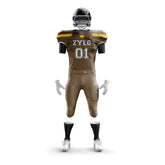What Is Moisture Wicking and How Does It Work for Team Jerseys?
In the high-stakes world of sports, every detail matters—from training regimens to equipment. One often-overlooked hero in athletic performance? Moisture-wicking team jerseys. These fabrics keep players dry, comfortable, and focused, whether they’re sprinting on a soccer field or battling in a basketball game. But how does this technology actually work, and why is it critical for team sports? Let’s break it down.
The Basics: What Is Moisture Wicking?
Moisture wicking refers to a fabric’s ability to pull sweat away from the skin to the outer surface, where it evaporates quickly. Unlike cotton, which absorbs moisture and stays damp, moisture-wicking materials keep athletes dry by accelerating evaporation. This process regulates body temperature, reduces chafing, and prevents the "heavy, soggy" feeling during intense activity.
The Science Behind the Technology
Moisture-wicking fabrics use two key principles: capillary action and hydrophobic fibers.
-
Capillary Action: Think of how a paper towel absorbs spills. Tiny gaps between fibers (or within yarns) act like microscopic straws, drawing sweat upward and outward.
-
Hydrophobic vs. Hydrophilic Fibers: Synthetic materials like polyester are hydrophobic (water-repelling), pushing moisture to the fabric’s surface. Some blends add hydrophilic (water-attracting) elements to enhance absorption.
This combo ensures sweat moves away from the skin, spreads thinly across the fabric, and dries fast.
Why Team Jerseys Need Moisture-Wicking Technology
Team sports demand endurance, agility, and focus—all of which suffer when players are drenched in sweat. Here’s why moisture management is non-negotiable:
1. Temperature Regulation
Sweat cools the body as it evaporates. Moisture-wicking jerseys speed up this process, preventing overheating during drills or games. For outdoor sports in hot climates, this can mean the difference between winning and heat exhaustion.
2. Reduced Friction and Discomfort
Wet fabric clings to skin, causing chafing and irritation. By staying dry, athletes avoid distractions and skin damage, especially in high-movement areas like underarms or thighs.
3. Odor Control
Sweat itself is odorless, but bacteria thrive in damp environments. Quick-drying fabrics limit bacterial growth, keeping jerseys fresher longer—a win for locker rooms and close-contact sports.
4. Enhanced Performance
A 2019 study in the Journal of Sports Science & Medicine found athletes wearing moisture-wicking gear reported 20% better focus and endurance compared to cotton users. Dry athletes move faster, react quicker, and stay confident.
How Moisture-Wicking Fabrics Are Made
Not all moisture-wicking fabrics are created equal. Here’s a look at common materials used in team jerseys:
Polyester
-
Pros: Durable, lightweight, and quick-drying. Often blended with spandex for stretch.
-
Cons: Can trap odors if not treated with antimicrobial coatings.
Nylon
-
Pros: Soft, resistant to abrasion, and dries faster than polyester.
-
Cons: Less breathable; often mixed with other fibers.
Merino Wool
-
Pros: Naturally odor-resistant and temperature-regulating.
-
Cons: Expensive and less durable for high-impact sports.
Blends (Polyester-Spandex, Nylon-Polyester)
-
Balance moisture management, flexibility, and durability. Ideal for sports like football or rugby.
Moisture Wicking Across Different Team Sports
Moisture-wicking technology is tailored to meet the unique demands of various sports:
-
Football Jerseys: Built to handle padding and high-impact collisions, these jerseys prioritize breathability and moisture control to combat sweat buildup under gear.
-
Basketball Jerseys: Lightweight and ventilated, they support rapid drying during fast-paced play.
-
Soccer Jerseys: Designed for endurance, they wick sweat efficiently during 90-minute matches, even in humid conditions.
-
Hockey Jerseys: Despite cold rinks, players sweat under layers. Moisture-wicking fabrics prevent clamminess beneath pads.
-
Baseball Jerseys: Blend moisture management with UV protection for outdoor games.
-
Rugby Jerseys: Reinforced seams and stretchy fabrics allow mobility while staying dry during tackles.
-
Volleyball Jerseys: Focus on stretch and sweat control for dynamic movements.
-
Esports Jerseys: Even in low-physicality settings, breathable fabrics keep gamers comfortable during long sessions.
Choosing the Right Moisture-Wicking Jersey for Your Team
Picking the best jersey involves more than just fabric type. Consider these factors:
1. Sport-Specific Needs
-
High-Intensity Sports (e.g., soccer, hockey): Opt for polyester blends with reinforced stitching.
-
Low-Intensity Sports (e.g., baseball): Lightweight nylon or merino wool for comfort.
2. Climate
-
Hot/Humid: Prioritize breathability and UV protection.
-
Cold: Look for thermal-regulating fabrics that wick while retaining heat.
3. Fit
-
Compression Fit: Enhances muscle support and maximizes skin-to-fabric contact for efficient wicking.
-
Loose Fit: Better for airflow in less intense activities.
4. Durability
Reinforced seams and anti-pill treatments ensure jerseys withstand frequent washes and rough play.
Caring for Moisture-Wicking Jerseys
Proper maintenance extends the life and effectiveness of the fabric:
-
Wash in Cold Water: Hot water breaks down fibers.
-
Skip Fabric Softeners: They clog fibers, reducing wicking ability.
-
Air-Dry or Tumble Dry Low: High heat can melt synthetic materials.
-
Treat Stains Promptly: Use enzyme-based detergents for sweat and grass marks.
Conclusion
Moisture-wicking technology isn’t a luxury—it’s a necessity for athletes who push their limits. By pulling sweat away, regulating temperature, and boosting comfort, these jerseys empower teams to perform at their peak. Whether you’re outfitting a youth league or a pro squad, investing in quality moisture-wicking gear pays off in stamina, focus, and wins.
Next time you suit up, remember: staying dry is just as important as training hard.




